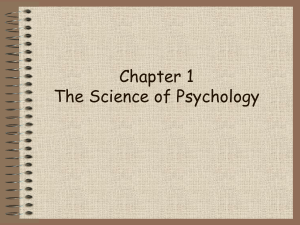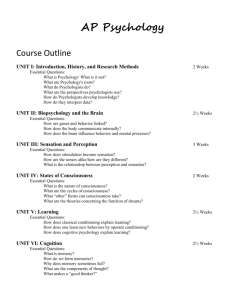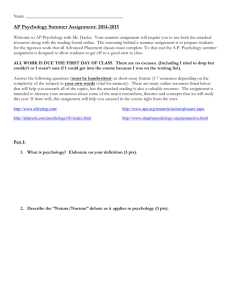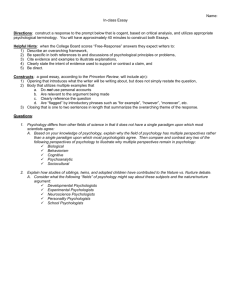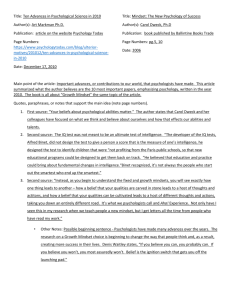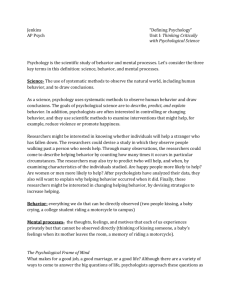Chapter 1 Psychology and Law
advertisement
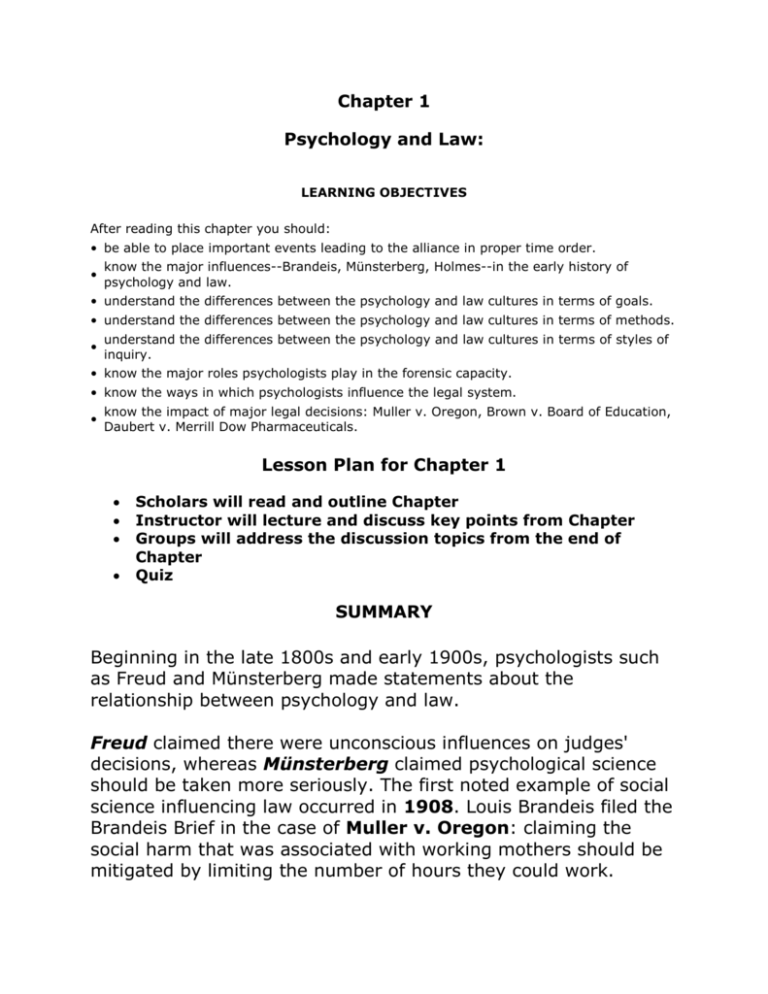
Chapter 1 Psychology and Law: LEARNING OBJECTIVES After reading this chapter you should: • be able to place important events leading to the alliance in proper time order. • know the major influences--Brandeis, Münsterberg, Holmes--in the early history of psychology and law. • understand the differences between the psychology and law cultures in terms of goals. • understand the differences between the psychology and law cultures in terms of methods. • understand the differences between the psychology and law cultures in terms of styles of inquiry. • know the major roles psychologists play in the forensic capacity. • know the ways in which psychologists influence the legal system. • know the impact of major legal decisions: Muller v. Oregon, Brown v. Board of Education, Daubert v. Merrill Dow Pharmaceuticals. Lesson Plan for Chapter 1 Scholars will read and outline Chapter Instructor will lecture and discuss key points from Chapter Groups will address the discussion topics from the end of Chapter Quiz SUMMARY Beginning in the late 1800s and early 1900s, psychologists such as Freud and Münsterberg made statements about the relationship between psychology and law. Freud claimed there were unconscious influences on judges' decisions, whereas Münsterberg claimed psychological science should be taken more seriously. The first noted example of social science influencing law occurred in 1908. Louis Brandeis filed the Brandeis Brief in the case of Muller v. Oregon: claiming the social harm that was associated with working mothers should be mitigated by limiting the number of hours they could work. In the 1930s when legal realism: the idea that laws could not be applied without regard for the social context and their social effects, emerged. The realists maintained that social science should inform public policy. During this time, Yale Law School hired its first faculty psychologist. Unfortunately, the conduct of social science research is more difficult than the realists imagined and the results much more complex than they had hoped. Until 1964, when social science influenced the decision in Brown v. the Board of Education, the effect of psychology on the legal system was unremarkable. This was followed by publication of The American Jury, a scientific treatise on jury decision-making, and The Crime of Punishment, an exposition on rehabilitation of criminals. Two prominent psychologists, George Miller and Donald Campbell, called for more attention to psychological research by the law community during this time. By the late 1960s the American Psychology-Law Society was formed, followed by the publication of its first interdisciplinary journal. There are three primary differences (i.e. goals, methods, and styles) between the cultures of psychology and law that likely hindered their cooperation. 1. Goals: Psychology aims to describe how people behave, law aims to proscribe how people should behave. Psychology aims to find the truth about behavior, law aims to punish illegal behavior. Whereas the legal system tries to avoid uncertainty by making unambiguous decisions, the very nature of the scientific method means that decisions are probabilistic and uncertain. Psychology typically deals with describing how groups behave in general (it is nomothetic), the law is concerned with how individuals behave (it is idiographic). This perhaps explains why law feels closest to clinical, rather than other types of, psychologists. 2. Methods: Law gives great deference to authority psychology is much more accepting of data from all levels of researchers. Law looks to past rulings and precedents which do not change over time to make its decisions. Psychological theories change dynamically with the collection of new data. 3. Style of inquiry: Lawyers must, according to the Code of Professional Responsibility, be advocates for their clients. They must take a side. Psychologists are assumed to be objective in their interpretation of their data. Psychologists play multiple roles informing law. They are advisors, evaluators, and reformers. As advisors, psychologists may give expert testimony, may be trial consultants, or may file briefs to inform the court about relevant findings. As evaluators, psychologists may evaluate the effectiveness of programs or public policies. When this is done to help amend the program or policy, it is called formative evaluation research. When it is conducted at the conclusion of a program to rate its effectiveness, it is called summative evaluation research. As reformers, psychologists must ask whether they have adequate evidence to suggest changes to a system that is based on history and tradition and whether they feel comfortable making such suggestions. Although there are many ways in which psychologists can influence the legal system. As expert witnesses, they can impart knowledge to the judge, lawyers, and jurors. However, judges are the gatekeepers who decide what expert testimony can be admitted. Based on the case of Daubert v. Merrill Dow Pharmaceuticals, four criteria were designed for judges to use in deciding the admissibility of expert testimony— a. the science to be presented must be falsifiable, b. must have undergone peer review, c. must have a known rate of error d. must be generally accepted by the scientific community. These are vague criteria and judges most often lack the scientific background to make educated judgments about the quality of the science to be presented. Additionally, lawyers may selectively choose the expert who will best support his or her case. These experts may serve as a. conduit-educators who attempt to give a fair and balanced account of the state of scientific knowledge on the topic. b. They may serve as philosopher-advocates who attempt to selectively report or exaggerate the facts to serve their own purpose, c. or they may act as hired guns. These are experts that actively choose what to say and how to say it to help the hiring side in a case. d. Psychologists may also choose to file amicus briefs. These are reports prepared and filed to help judges understand the research that has been conducted on certain relevant topics. Researchers attempt to publicize their results and to influence legislatures and policy through testimony and lobbying.

